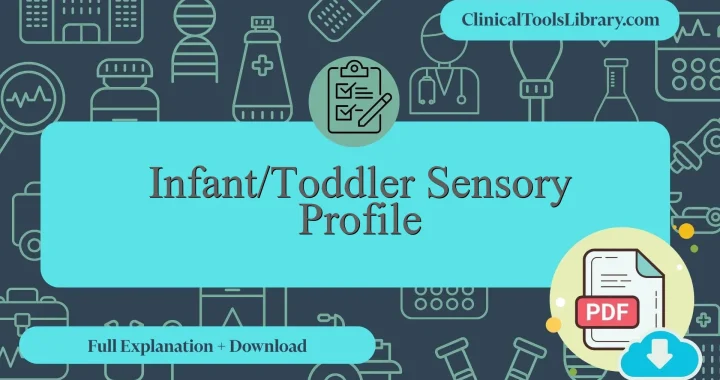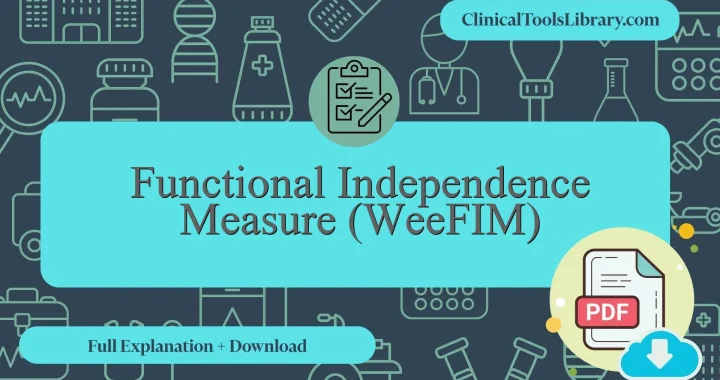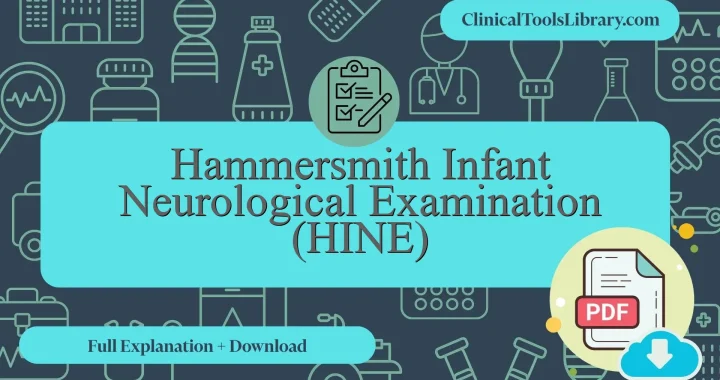In this article, we explain everything you need to know about the Infant/Toddler Sensory Profile. We will cover the aspects it evaluates, the target population, a detailed step-by-step explanation, and how to interpret its results. Additionally, we will dive into the scientific evidence supporting this tool (diagnostic sensitivity and specificity) in clinical assessment. You will also find official and unofficial sources available for download in PDF format.
What does the Infant/Toddler Sensory Profile assess?
The Infant/Toddler Sensory Profile is a standardized assessment tool designed to evaluate sensory processing abilities in children aged birth to 36 months. It systematically gathers caregiver observations regarding the child’s responses to sensory experiences across various modalities, including tactile, auditory, visual, and vestibular systems. The primary purpose of this instrument is to identify atypical sensory patterns that may impact an infant’s or toddler’s developmental trajectory and daily functioning, which can be essential for early intervention planning. Clinicians often utilize the Infant/Toddler Sensory Profile scoring method to quantify these sensory behaviors, providing objective data that supports diagnosis and individualized therapeutic approaches. Access to the Infant toddler sensory profile questionnaire pdf or the Infant toddler sensory profile pdf free download facilitates widespread application in clinical and research settings, ensuring reliable information is obtained from caregivers efficiently.
For which type of patients or populations is the Infant/Toddler Sensory Profile intended?
The Infant/Toddler Sensory Profile is indicated primarily for children aged 0 to 36 months who may exhibit atypical sensory processing patterns. It is widely utilized in clinical contexts involving populations with developmental delays, spectrum disorders such as autism spectrum disorder (ASD), and sensory modulation difficulties. The tool facilitates early identification of sensory processing issues that could impact feeding, sleep, and motor development. Clinicians often use the Infant/Toddler Sensory Profile questionnaire PDF to guide intervention planning and track progress over time. This assessment is particularly beneficial in multidisciplinary evaluations within pediatric occupational therapy, early intervention programs, and multidisciplinary developmental clinics to optimize individualized therapeutic strategies.
Step-by-Step Explanation of the Infant/Toddler Sensory Profile
The Infant/Toddler Sensory Profile consists of 48 items designed to assess sensory processing patterns in children from birth to 36 months. Each item presents statements relating to behaviors in various sensory systems, including auditory, visual, tactile, vestibular, and oral sensory processing. Caregivers respond using a five-point Likert scale, ranging from “Almost Never” to “Almost Always,” reflecting the frequency of observed behaviors. The administrator instructs caregivers to consider the child’s typical behavior in familiar environments during the past month. After completion, raw scores are calculated for sensory processing patterns such as sensory sensitivity, sensation avoiding, and low registration, which assist clinicians in identifying potential sensory-related disorders such as autism spectrum disorder or sensory processing disorder. Proper interpretation requires comparing scores against normative data to determine areas of concern and guide targeted interventions.
Infant/Toddler Sensory Profile PDF Download: Questionnaire & Scoring Materials Available
Below are the downloadable resources available in both the original language and English versions of the Infant/Toddler Sensory Profile in PDF format. These files include the Infant toddler sensory profile questionnaire pdf and related scoring materials, designed to facilitate comprehensive assessment in clinical and research settings. Providing access to the Infant toddler sensory profile pdf free download ensures practitioners can efficiently implement standardized evaluation protocols for early identification of sensory processing patterns in young children.
How to interpret the results of the Infant/Toddler Sensory Profile?
The results of the Infant/Toddler Sensory Profile test are interpreted by comparing individual scores to established normative reference ranges, which classify sensory processing patterns into categories such as typical, probable difference, and definite difference. Scores falling within the typical range indicate expected sensory responsiveness, while those in the probable and definite difference ranges suggest varying levels of sensory processing challenges. For example, a score exceeding 1.5 standard deviations above the mean in areas like sensory sensitivity or sensory avoiding may warrant further clinical evaluation. Healthcare professionals utilize these results to identify potential sensory modulation disorders and to tailor intervention plans, ensuring that therapeutic strategies address specific sensory processing needs and improve functional outcomes in children with developmental delays or autism spectrum disorder. The interpretation formula commonly used is z = (X – μ) / σ, where X represents the individual raw score, μ the population mean, and σ the standard deviation.
What scientific evidence supports the Infant/Toddler Sensory Profile ?
The Infant/Toddler Sensory Profile was developed by Dr. Winnie Dunn in the 1990s as a caregiver questionnaire aimed at evaluating sensory processing abilities in children aged birth to 36 months. Its validation involved extensive normative data collection from diverse populations, establishing reliable scores across multiple sensory domains such as auditory, visual, tactile, and vestibular processing. Psychometric analyses have demonstrated its internal consistency, test-retest reliability, and construct validity, making it a robust tool for identifying sensory processing patterns associated with conditions like autism spectrum disorder and attention deficit hyperactivity disorder. Peer-reviewed studies have further supported its clinical utility in early detection and intervention planning, particularly by correlating sensory processing differences with developmental outcomes during critical periods of neurodevelopment.
Diagnostic Accuracy: Sensitivity and Specificity of the Infant/Toddler Sensory Profile
The Infant/Toddler Sensory Profile demonstrates variable sensitivity and specificity depending on the population and clinical context. Studies indicate sensitivity values ranging from approximately 0.70 to 0.85, reflecting moderate ability to correctly identify children with sensory processing difficulties. Specificity is generally higher, reported between 0.75 and 0.90, indicating strong performance in ruling out children without such disorders. These metrics support its use as a screening tool for detecting sensory processing disorder in infants and toddlers, though further assessment is recommended for diagnostic confirmation. Overall, the instrument provides clinically relevant psychometric properties appropriate for early identification in pediatric practice.
Related Scales or Questionnaires
The Infant/Toddler Sensory Profile is comparable to several validated assessment tools such as the DeGangi-Berk Test of Sensory Integration (TSI) and the Test of Sensory Functions in Infants (TSFI), which are also explained and available for download on ClinicalToolsLibrary.com. The DeGangi-Berk TSI offers a direct clinical observation approach focusing on vestibular and somatosensory processing, advantageous for identifying sensory modulation disorders in young children; however, it requires specialized training and longer administration time compared to the caregiver-report format of the Infant/Toddler Sensory Profile questionnaire. The TSFI provides a structured play-based evaluation but is limited by a narrower age range and a more extensive administration protocol. Unlike these, the Infant/Toddler Sensory Profile, with resources like the Infant toddler sensory profile questionnaire pdf free, allows efficient scoring and interpretation accessible to a broader range of practitioners, supporting timely intervention planning. These comparative scales’ psychometric properties, including reliability and validity, are detailed alongside the Infant/Toddler Sensory Profile scoring guidelines on the website, aiding clinicians in choosing the most appropriate tool based on clinical context and population characteristics.




